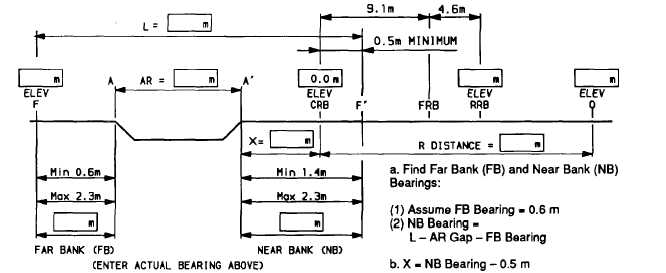ARMY TM 5-5420-212-10-1
MARINE CORPS TM 08676A-10/1-1
(a)
Add the excess bearing to the initial far bank bearing (0.6 m).
or
(b)
Add the initial far bank and near bank bearings together, then divide by 2, resulting in an equal
amount of bearing on both banks.
or
(c)
Add the initial far bank and near bank bearings together, then divide the total bearing as you see fit,
as long as minimums are met and maximums are not exceeded.
(2)
Regardless of what is done, the locations of the F, F’, CRB, FRB, RRB and O pegs will change or shift
on the site. The location of the A and A’ pegs do not change, nor does the width of the AR Gap.
(3)
There are situations that will result in the maximum bearings being exceeded on both banks, due to the
overlaps of gaps and bridge lengths or by making an error in the deign process. When this occurs:
either
(a)
Dig out the soil from the bank until the bearing area will be less than the maximum.
or
(b)
Pack up (place timbers) under the end of bridge upon completion. This packing must provide
enough bearing surface to equal the minimum bearing for the bridge.
j.
Key construction points
Locate the key construction points on the site and take elevations as follows:
(1)
Estimate or measure the elevations of the F, CRB, FRB, RRB, and O pegs. Convert the elevation of the
CRB to Datum, 0.0 elevation.
(2)
Convert the elevations of the F, CRB, RRB and O pegs, using the CRB as Datum. Elevations above the
datum lines are positive, elevations below Datum are negative.
(3)
Place the elevations on the pro-forma as shown in Figure 3-13.
FIGURE 3-13 Site Profile DS 13-22 Bay w/o LRS
3-37

